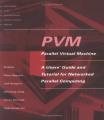
How to Write Parallel Programs: A First Course
by Nicholas Carriero, David Gelernter
Publisher: MIT Press 1992
ISBN/ASIN: 026203171X
ISBN-13: 9780262031714
Number of pages: 246
Description:
In the not-too-distant future every programmer, software engineer, and computer scientist will need to understand parallelism, a powerful and proven way to run programs fast. The authors of this straightforward tutorial explain why this is so and provide the instruction that will transform ordinary programmers into parallel programmers.
Download or read it online for free here:
Download link
(1.1MB, PDF)
Similar books
 BIG CPU, BIG DATA: Solving the World's Toughest Problems with Parallel Computing
BIG CPU, BIG DATA: Solving the World's Toughest Problems with Parallel Computingby Alan Kaminsky - Rochester Institute of Technology
With the book BIG CPU, BIG DATA, my goal is to teach you how to write parallel programs that take full advantage of the vast processing power of modern multicore computers, compute clusters, and graphics processing unit (GPU) accelerators.
(7088 views)
 Parallel Programming with Microsoft .NET
Parallel Programming with Microsoft .NETby Colin Campbell, Ralph Johnson, Stephen Toub - Microsoft Press
A book that introduces .NET programmers to patterns for including parallelism in their applications. Examples of these patterns are parallel loops, parallel tasks and data aggregation with map-reduce. Each pattern has its own chapter.
(14703 views)
 A Framework for Enabling Distributed Applications on the Internet
A Framework for Enabling Distributed Applications on the Internetby Mark Anthony McLaughlin - arXiv
Internet distributed applications (IDAs) are internet applications with which many users interact simultaneously. In this paper the author provides a basis for a framework that combines IDAs collectively within a single context.
(8675 views)
 PVM: Parallel Virtual Machine
PVM: Parallel Virtual Machineby Al Geist, at al. - The MIT Press
Written by the team that developed the software, this tutorial is the definitive resource for scientists, engineers, and other computer users who want to use PVM to increase the flexibility and power of their high-performance computing resources.
(12053 views)